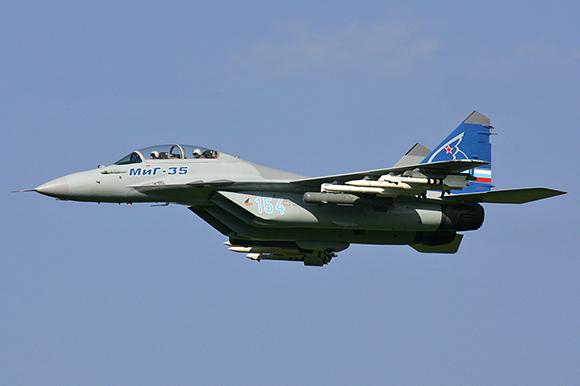By the end of the summer the Mikoyan MiG-35 Fulcrum-F will complete flight tests: deliveries could begin next year. The Russian Air Force, which has not yet officially adopted the new MiG-35, has committed to purchase a first batch of 37 aircraft that will become fully operational by 2020. Despite the accumulated delays, Mikoyan guarantees a high production rate to make up for lost time.
The MiG-35 is clearly an evolution of the much-loved MiG-29, although it is classified as a fighter of 4 ++ or advanced fourth generation. This term identifies a platform that presents fifth-generation devices implemented on a design evolved from the previous one. Not really a fighter stealth, but which has various features such as, for example, low observability, avionics and vector thrust.
Il Super Hornet and the Eurofighter Typhoon, respectively fighters for the air superiority of the US Navy and almost all NATO countries, are advanced fourth-generation fighters.
The new MiG was presented for the first time in an air show in Bangalore, the 2007. Take advantage of the know-how acquired with the MiG-29 SMT Sokol (among these the S-31E2 KOLS system), developed towards the end of the nineties on the MiG-29S cell Gorbatyi. Sokol presents all the improvements introduced in the stage improvements of the Gorbatyi, in addition to being coated with a new absorbing radar paint.
The MiG-35 is the 30 percent larger than the MiG-29 and in the intentions of Mikoyan-Gurevich, it will stand alongside the T-50 as a low-cost lightweight platform for air superiority. Compared to the original Fulcrum, the MiG-35 presents a new control system fly-by-wire. The MiG-29 is lighter than the MiG-35, thanks to its wide use of composite materials. The MiG-XNUMX is able to transport more fuel with a new digital management system.
The MiG-35 was initially designed for a thrust vector propulsion system. It is powered by two RD-33MKBs, also available in the vector-push variant (three hydraulic actuators that divert the nozzles mounted around the engine nacelle). Recent reports highlight "exceptional" capabilities for the evolution of the RD-33 engine. The Russian designers would have solved several critical issues that gripped previous models, such as poor reliability and smoke emission.
The MiG-35 can climb at the rate of 330 m / s with a maximum speed of 2.400 kilometers per hour. Its range is 2.000 km in a clean configuration, extended to 3.100 km with additional external pods. It weighs around 11,000kg with a maximum takeoff weight of 29,700kg. The single and two-seater D versions of the MiG-35 will not upset the final design of the airframe: a way to maximize the effectiveness of the same production line. The MiG-35 will incorporate the Zhuk-MA electronically-scanned radar, capable of tracking targets at distances beyond 85 nautical miles. It will be equipped with an OLS tracking system, a passive air-to-air electro-optical sensor that operates in both infrared and visual wavelengths. OLS makes the aircraft less dependent on ground control interception, allowing it to carry out independent multi-role missions. The Russians believe the OLS infrared sensor will be key in identifying aircraft stealth like the F-22 and the F-35.
Finally, there is one last particularly interesting fact: the cost. A MiG-35, in its most performing version, costs 40 million dollars. If it confirmed the expectations, the Russians could buy 100 in the short term (up to triple that number), but it is internationally (proposed with Zhuk-AE electronic scanning radar) that the MiG-35 could prove to be a real g. Egypt has practically closed for the MiG-35 as a new platform for air superiority. A decision that could redraw the balance in the Region.
The easy cost of access makes the 4 ++ platform attractive to many countries.
(photo: Dmitriy Pichugin)












